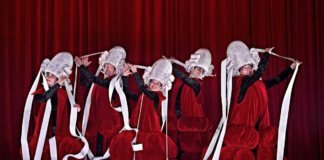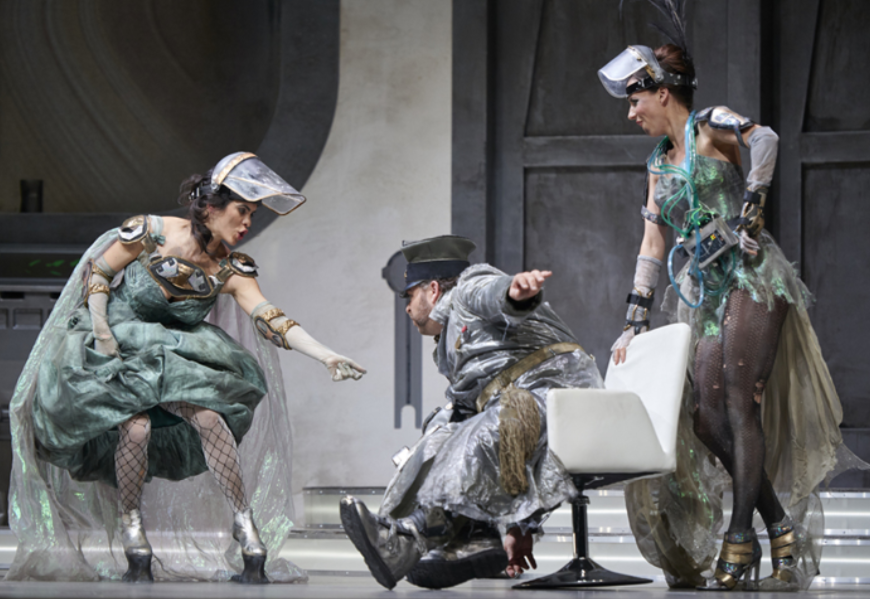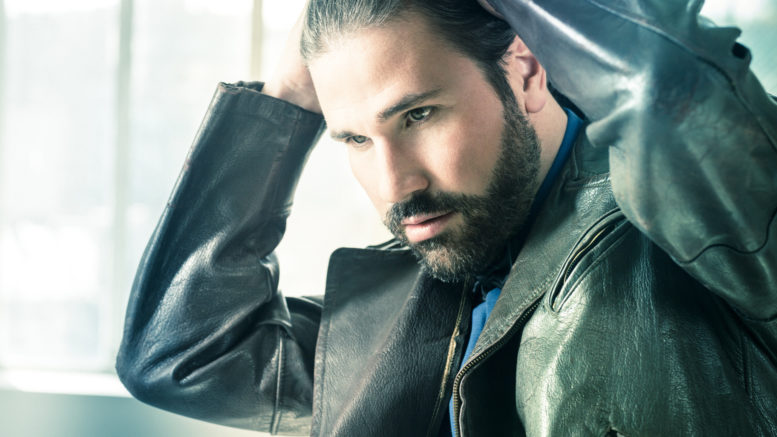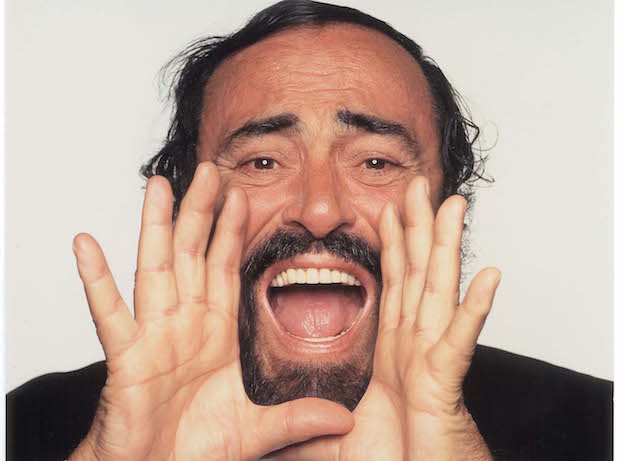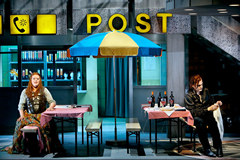 |
|
|
The bosses of the Bayreuth Festival, Katharina Wagner and Eva Wagner-Pasquier – successors to their late father Wolfgang – took a calculated risk in picking Berlin-based avant-garde theatre director Frank Castorf to direct the bicentennial Ring cycle. First choice, incidentally, was Düsseldorf-born, Oscar-nominated filmmaker, Wim Wenders.Castorf is a controversial figure – and even more controversial after this Ring – some of his productions have been called ‘illogical’ and ‘rejecting a linear narrative.’ That, I guess, is power for the cause at Bayreuth at the moment. But for my money he pulled off the Herculean task with flying colours, offering a Ring to be reckoned with and one, indeed, to be remembered – if for the wrong reasons in some quarters.
However, what goes on the stage at Bayreuth’s Festspielhaus has become much more daring in recent years since the Wagner sisters – who are renegotiating their contracts beyond the 2015 expiry date – took over. Therefore, choosing Castorf, who has rather limited experience in the field of opera, keeps faithfully to their artistic vision. Such bold and daring productions such as Castorf’s Ring are the way forward at Bayreuth to keep the place alive, healthy and on course for future generations. But I doubt whether the old guard or the visually sensitive would agree. A renowned deconstructionist, Castorf is as artistically adventurous as they come. In Berlin he readily grabs the headlines for being the prolific and somewhat dogmatic Intendant of the Volksbühne in Linienstraße, part of former East Germany. His productions have involved incessant screaming and garbage-littered stages. A few discarded old tabloid pages (most probably with bad reviews) found their way on to the sets of Walküre and Siegfried. And one of Castorf’s most notorious productions was a five-hour-long production of Berlin Alexanderplatz, adapted from Alfred Döblin’s 1929 novel of the same name, whose protagonist, ex-convict Franz Biberkopf, struggles against all the odds to survive coping with misery, crime and the imminent rise of Nazism in Berlin during the 1920s. Therefore, Castorf has been untamed in so much of his work. He also possesses a fondness for tinkering about with scripts. However, the Wagner sisters cornered him in this respect inserting a clause into his contract stating that Wagner’s words and music must remain intact – fully intact. He duly obliged. But such a clause didn’t cramp his style. His direction of the Ring offered him huge opportunities to explore new ideas. One significant change was swapping the greed for gold for the greed for oil, the black gold of modern times. Thus oil became the treasured Nibelung horde and the American state of Texas became the setting for Rheingold, while Walküre found itself transported to the city of Baku on the Caspian Sea in pre-Revolutionary Russia. The set of Siegfried – like all of the sets built on a revolving stage – was monumental to say the least showing the carved heads of Communist chiefs Marx, Lenin, Stalin and Mao in a Mount Rushmore style setting, complemented by Berlin’s Alexanderplatz, a masterpiece of ‘new realism’ design. Götterdämmerung, in stark contrast to socialist dreams, was given over to Wall Street with the façade of the New York Stock Exchange dominating the set counterbalanced by a ruined tenement block in a run-down area of New York showing Hagen and Gunther scheming and making a living from a pizza takeaway joint and Gutrune whizzing about in a BMW Isetta bubble car. A seedy motel on Route 66, aptly named ‘Golden’, complete with a couple of gas pumps and cluttered with paraphernalia, provided the setting for Rheingold capturing in minute detail the very essence and authenticity of the free-and-easy decade of the 1950s when oil supplies were limitless to Americans who cruised aimlessly around in their chrome-trimmed gas-guzzling cadillacs as if there was no tomorrow. But tomorrow always comes as the gods holed up in Valhalla find out to their mighty cost. And a Mercedes-Benz chrome-trimmed black convertible provided a most distinctive (and distinguished) stage prop and the favoured transport of the Rhinemaidens who were brightly-dressed curvaceous young blonde whores tantalising poor old Alberich to bursting-point with their seductive charms. The famed trio – Mirella Hagen (Woglinde), Julia Rutigliano (Wellgunde) and Okka von der Damerau (Flosshilde) – sang and acted their roles superbly. On top of all this we were treated to the Woodbird (lavishly dressed in Rio Carnival fashion) coming down on Siegfried in a rash moment of passion, Erda performing an indecent act on Wotan in a pasta restaurant only to be coitus interruptus by the waiter bringing him the bill, Siegfried pinning Gutrune to the wall, the Norns practising witchcraft and a couple of crocodiles crawling about Alexanderplatz bringing the jungle to the city routing for their share of the spoils while Fafner meeting his fate with a quick round from an AK47 Kalashnikov rifle. Where was Nothung? Somewhere! Got the picture? But whatever brickbats are thrown at Castorf he created an exciting Ring and gathered around him an inspiring creative team too, most notably the 1960s Serbian-born set designer, Aleksandar Denic, who collaborated with Castorf on The Lady of the Camelias seen in Paris last year. His sets perfectly fitted a revolving stage of about 16-18 metres in diameter (that’s large!) and were imaginative to the core while the video work of Andreas Deinert and Jens Crull was second to none. In actual fact, video work was paramount in the production overall especially in Rhinegold and Walküre with an on-stage cameraman catching major parts of the action which was immediately projected to the audience on a large screen. At times it was slightly distracting, but technology is what modern musical theatre and opera production is all about and it does have its advantages. Plus it saved the need for opera glasses! In Walküre, for instance, when Sieglinde ‘prescribes’ Hunding a sleeping-pill so she can beat a path to Siegmund one catches Hunding ‘close-up’ on screen tossing about from one side of the bed to the other while the two incestuous twin lovers are in ecstatic embrace below in a scene bereft of any camera action. The ‘loving couple’ were perfectly matched and sung by South African tenor Johan Botha and Italian-American soprano Anja Kampe. Their big scene is one of the most fragile and special moments in all of the opera and they were on brilliant form putting in a performance of great magnitude, strength and beauty. Kampe’s soaring soprano voice was simply pure delight and her deep sadness matched her brother’s fate. And, boy, didn’t the audience let them know whose side they were on when they took their curtain-call. Wolfgang Koch put in a comfortable and commanding performance as Wotan/Der Wanderer, the dubious-looking manager of the ‘Golden’ motel and later boss of the oil-field in Walküre (man of many parts, eh!), while the giants Fafner and Fasolt were bullishly sung by Bucharest-born bass-baritone Sorin Coliban (a future Wotan?) and Austrian bass Günther Groissböck. Portrayed as ‘grease-monkeys’ they were kitted out in true Detroit fashion with blue dungarees with Fafner walking tall armed with a baseball bat. Gangsters and their hookers replaced Nordic gods with Donner, sung menacingly by Ukrainian baritone Oleksandr Pushniak, resembling a member of the Mafioso complete with Stetson and armed with a revolver while Norbert Ernst’s Loge, suitably attired for pyrotechnical action, looked quite dapper in a flaming-red suit incessantly lighting a Zippo cigarette lighter. He played his role to the full in a cheeky and casual manner as befits his character, while Erda, goddess of wisdom, incredibly sung by mezzo Nadine Weissmann, gave Wotan more than a run for his money as well as a piece of her mind. She looked glam from top to toe dressed in a nice bright frock and white fur coat befitting her reincarnation as a cabaret girl. The Rhine seemed a long way off. But suddenly there it was represented by the motel’s swimming pool (I nearly missed it!) complete with large soft plastic play-balls and a yellow duck which suited the childish antics of Alberich splashing in and out diving for the ‘golden’ bounty. And to sort out the underground home of Nibelheim, what better thinking than come up with a silver-plated Air Stream mobile trailer. Martin Winkler as Alberich and Burkhard Ulrich as his half-brother Mime were well-suited to one another, quick-witted, crafty and nasty, while Attila Jun’s reading of the beastly role of Hagen was mean and menacing to the core. The soprano Catherine Foster (Brünnhilde) – the first English singer to take on the role at Bayreuth – ran into a little bit of turbulence in Walküre and Götterdämmerung in the first cycle (unfairly so, by all accounts) and Lance Ryan and Attila Jun felt a tremor or two as well but apart from that things fared pretty well for the other members of the cast. I attended the second cycle and I can happily say that Ms Foster – whose voice is lyrical to the extreme – delivered the goods in a joyous and well-balanced performance that manifested itself in a brilliant finale with the famous immolation scene in Götterdämmerung where she tears her heart out realising the consequences of lust, greed and corruption that lie at the very heart of the Ring are completely and utterly worthless. Ms Foster hit the right note and surely made her mark on her Bayreuth début. She must be pleased: the audience certainly were. Brava! And Canadian-born Heldentenor Lance Ryan showed youth and athleticism in the demanding role of Siegfried, a part he has played many times. Looking young and guileless one moment and acting gloriously immature the next, his voice carried well into the vast auditorium of the Festspielhaus in a technically-assured performance. Maestro Petrenko’s command and reading of Wagner’s gargantuan score was heavenly and moving at times and he energised his charges in some formidable playing especially in the big production numbers such as the Gods’ entrance into Valhalla in Das Rheingold, Siegfried’s momentous Rhine journey and the funeral march from Götterdämmerung. But for some members of the audience it was all a bit too much and at curtain call the Bayreuth booing mafia was out in force but their target was aimed directly at Castorf and his creative team. What audiences see and hear at Bayreuth are complete opposites. It’s normally what they see they don’t like although singers do sometimes get it in the neck. However Castorf’s Ring was full of interesting scenes and one in particular that I’ll take away with me is where Waltraute begs Brünnhilde in Götterdämmerung to return the Ring to the Rhinemaidens to end the curse. Singing the role of Waltraute was German mezzo-soprano, Claudia Mahnke, making her Bayreuth début. And what a début! Her singing was simply beautiful and she put in a tender and passionate performance showing great concern for her Valkyrie sister. The opening night of the festival was attended by the great and the good as is the usual custom and Chancellor Angela Merkel and President Joachim Gauck were out in force and treated to a performance of Der fliegende Holländer, last season’s new offering. Despite the boos for my money directors who push boundaries have their following – even at Bayreuth. I’m more than ready to see Castorf’s Ring again and revisiting Holländer and Tannhäuser had more than its rewards. Bayreuth remains most definitely the place to see, hear and soak up Wagner. As Bob Dylan said ‘The times are a-changing!’ They certainly are, especially at Bayreuth. Happy anniversary, Richard! |
|
| Text © Tony Cooper Photo © Bayreuther Festspiele / Enrico Nawrath |






